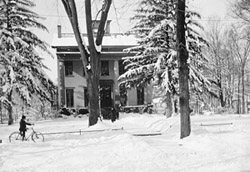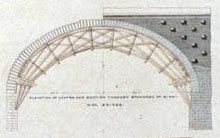 Jervis bequeathed his home and personal library to the city of Rome, New York, to be used as a public library. His personal library is kept intact as a memorial and for research purposes. The papers of John Jervis number in the thousands, and include memoirs, manuscripts of books he authored, scrapbooks, folios and quartos, nearly 600 engineering plans and drawings (some in watercolor), maps, public documents, and countless letters and reports. His library also includes 1,800 monograph volumes on general topics as well as a concentration on applied sciences and civil engineering. Copyrights and dates of publication range from the 1670's through the 1880's.
Jervis bequeathed his home and personal library to the city of Rome, New York, to be used as a public library. His personal library is kept intact as a memorial and for research purposes. The papers of John Jervis number in the thousands, and include memoirs, manuscripts of books he authored, scrapbooks, folios and quartos, nearly 600 engineering plans and drawings (some in watercolor), maps, public documents, and countless letters and reports. His library also includes 1,800 monograph volumes on general topics as well as a concentration on applied sciences and civil engineering. Copyrights and dates of publication range from the 1670's through the 1880's.
Jervis began his career in Rome as an Axeman for an Erie Canal survey party in 1817. By 1823 he was superintendent of a fifty-mile section of the Erie Canal. In 1827 he was appointed Chief Engineer of the Delaware and Hudson Canal project. It was John Jervis who suggested that a railroad be incorporated into this project. At this time there were no railroads in America, but Jervis won approval of his idea and even designed the railroad's locomotive, the Stourbridge Lion, the first locomotive to run in America. In honor of his work on the Delaware and Hudson, Port Jervis, N.Y., is named for him.
 In 1830, as Chief Engineer of the Mohawk & Hudson Railway (the first section of what was later to be the N.Y. Central R. R.), Jervis designed "The Experiment." This was the first locomotive in the world to have a free-swinging, four-wheel front truck, which gave the vehicle greater maneuverability and enabled it to travel at an unprecedented speed of eighty miles per hour. The Jervis design became the standard American design.
In 1830, as Chief Engineer of the Mohawk & Hudson Railway (the first section of what was later to be the N.Y. Central R. R.), Jervis designed "The Experiment." This was the first locomotive in the world to have a free-swinging, four-wheel front truck, which gave the vehicle greater maneuverability and enabled it to travel at an unprecedented speed of eighty miles per hour. The Jervis design became the standard American design.
The monumental task of building New York City's forty-one mile water-supply system (The Croton Aqueduct) was given to Jervis in 1836. The system included the Croton Dam, the Ossining Bridge, the Harlem River Bridge, the Receiving, Equalizing, and Distributing Reservoirs on Manhattan, as well as the magnificent embankments, tunnels, and arches employed throughout the aqueduct system. (Original illustrations and engravings of these structures are preserved in the Smithsonian Institution and in the Library of Congress). The six-year project employed over 4,000 workers, and when completed, carried seventy-five million gallons daily to New York City.
 Jervis's other notable contributions include the design and construction of the following: the ninety-eight mile Chenango Canal (1833), the enlargement of the eastern division of the Erie Canal (1834), the Boston water supply project (1846), the Hudson River R. R. (1847-1850), the Michigan Southern & Northern Indiana R.R., the Chicago & Rock Island R.R. (1850 - 1858), and he was general Superintendent of the Pittsburgh, Fort Wayne & Chicago Railway (1861-64). Again, we must stress that these undertakings were "pioneering" ventures. Jervis's projects were filled with "first" and "untried" engineering principles, and as such, were "schools" for a generation of American civil engineers.
Jervis's other notable contributions include the design and construction of the following: the ninety-eight mile Chenango Canal (1833), the enlargement of the eastern division of the Erie Canal (1834), the Boston water supply project (1846), the Hudson River R. R. (1847-1850), the Michigan Southern & Northern Indiana R.R., the Chicago & Rock Island R.R. (1850 - 1858), and he was general Superintendent of the Pittsburgh, Fort Wayne & Chicago Railway (1861-64). Again, we must stress that these undertakings were "pioneering" ventures. Jervis's projects were filled with "first" and "untried" engineering principles, and as such, were "schools" for a generation of American civil engineers.
BUY WITH CONFIDENCE
I am a true professional philatelist, doing this for a living since 1995.
I have divided collections into auction lots and described auction lots for many major auction houses.
In other words, you get what you pay for.
SHIPPING
Both domestic and international is by USPS first class mail. Domestic is with insurance. The shipping charge is $.58 postage + $3.85 USPS insurance + $.78 eBay fees (yes eBay charges full commission and fees on shipping charges and sales tax!).
If you purchase multiple items and you wait for me to send you an invoice then I am pleased to combine shipping. If you do not wait for me to send you an invoice then you will pay more for shipping.